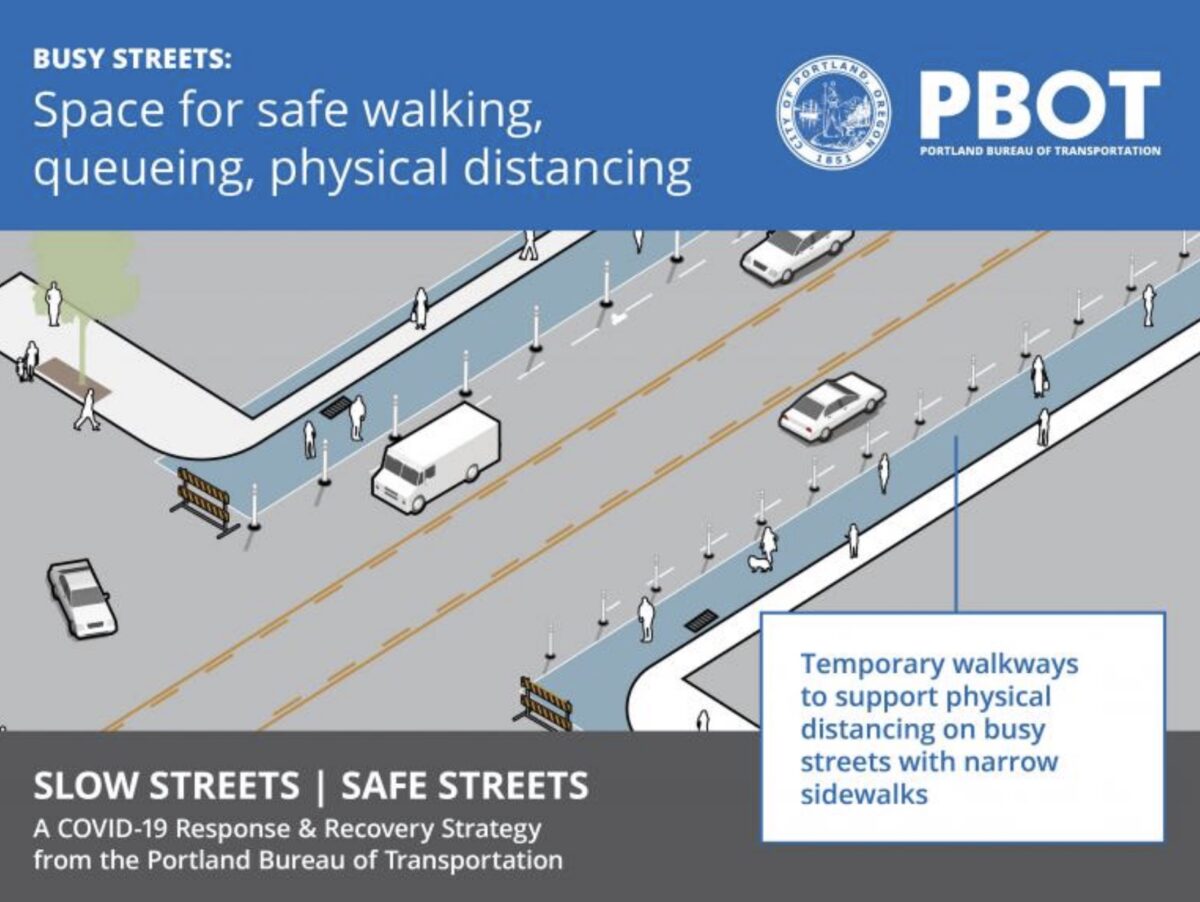
The Portland Bureau of Transportation has revealed a plan to adapt our streets to the COVID-19 crisis.
“The new strategy will repurpose streets, including closing them to car traffic, to make it easier and safer for Portlanders to practice physical distancing as the city recovers,” reads a statement just released by PBOT by way of Commissioner Chloe Eudaly.
Here’s the full announcement:
“After weeks of bureau analysis and community outreach, the initiative maps how PBOT will reconfigure streets—including closing them to through car traffic—to support physical distancing, address increased movement, and support the City of Portland’s re-opening process.
“Right now, the best thing Portlanders can do for the health of our community is to continue to stay home to save lives. PBOT is carefully considering how transportation behavior has changed and how it needs to change, not just as we recover from this crisis, but to support a sustainable future,” said Transportation Commissioner Chloe Eudaly. “Our Slow Streets|Safe Streets Initiative will provide the space Portlanders need to move around our city safely, and improve how we share our right of way. I am proud of PBOT’s leadership on this issue. We have been responsive to community advocates and business concerns while balancing the vital need to prioritize public health and vulnerable Portlanders. Our streets belong to all of us, and these improvements will allow us to safely walk, bike, and roll through the city.”
PBOT is proposing a series of steps and measured improvements for neighborhood greenways, busy streets, and business districts. The bureau will focus its initial efforts on areas of the city with the most pressing safety needs.
These planned steps include:
1. Neighborhood Greenways: (quiet residential streets): During the public health emergency, neighborhood greenways have emerged as a critical space for Portlanders seeking to get out and about safely near their homes. The 100 miles of greenways throughout Portland are specifically designed to prioritize safety and comfort for people walking and biking. These streets have provided a safe space for Portlanders to walk, bike, and roll while maintaining physical distancing.
One of the first steps the bureau will take as part of the initiative will be to install temporary barricades, to either close certain streets to all but local traffic, or slow traffic where a full closure is not feasible. The bureau will also install signage to alert drivers to the presence and priority of people walking and biking on the greenways.
2. Busy Streets: Expand pedestrian space along streets that are narrow or missing sidewalks to improve safety. Provide more room for physical distancing at intersections with high foot traffic. Install pop-up walking and biking lanes to encourage local trips on foot or by bike.
3. Business districts: reserve space so customers can line up while maintaining appropriate physical distancing; create dedicated loading zones for pickup and delivery.
During the pandemic, Portland has experienced dramatic changes to the city’s transportation system.
There has been a significant decrease in traffic and congestion. Across the city, car trips have been down almost 50 percent. According to data from the traffic app Waze, the number of traffic jams has fallen by 88 percent. At the same time, incidents of speeding have risen almost a third since the start of the public health emergency.
Finally, more Portlanders have been using neighborhood streets—including the city’s network of neighborhood greenways—to exercise and get fresh air while practicing safe physical distancing.
“When we reach the point that we can re-open, we want to make sure our transportation system is ready,” said Director Chris Warner. “Portlanders have made great use of their neighborhood streets to walk, bike, and roll during the pandemic. We’ve designed the Slow Streets|Safe Streets initiative to make sure they can continue to do this safely as we get back closer to normal.”
In the coming weeks, PBOT will hold a series of digital meetings with community, business, and neighborhood groups to collect input on how our streets can best serve all Portlanders both during and after this public health crisis. If members of the public have suggestions for locations where street improvements could support safe physical distancing, please contact PBOT at 503-823-SAFE or email: active.transportation@Portlandoregon.gov. Planning and preparation is underway for these actions, and the Slow Streets|Safe Streets initiative will begin to launch immediately with additional phases timed to launch when the Governor’s Office and public health officials officially start the re-opening process.
PBOT and Commissioner Eudaly have been under intense pressure for weeks to make a move like this. Just one week ago Commissioner Eudaly told an Oregon Public Broadcasting radio show host: “I don’t think that right now while we’re under ‘Stay at Home stay safe’ orders, that encouraging people to leave their homes and making radical changes with the way streets are used, are the best use of our time and resources. And I’m also very concerned about public safety.”
A PBOT planner will share more details of their plans at a meeting of the city’s Bicycle Advisory Committee which is open to the public and will be held via Zoom tonight at 6:00 pm.
— Jonathan Maus: (503) 706-8804, @jonathan_maus on Twitter and jonathan@bikeportland.org
— Get our headlines delivered to your inbox.
— Support this independent community media outlet with a one-time contribution or monthly subscription.


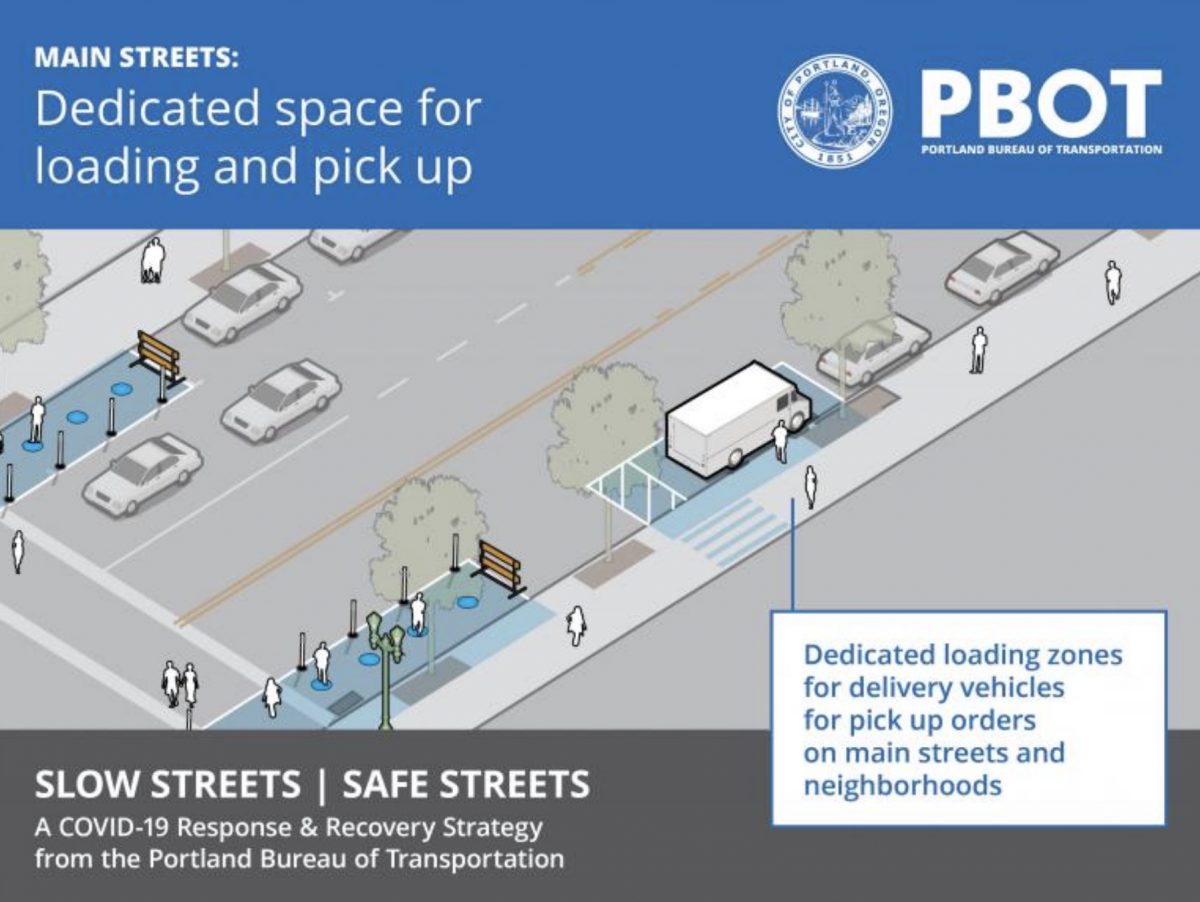
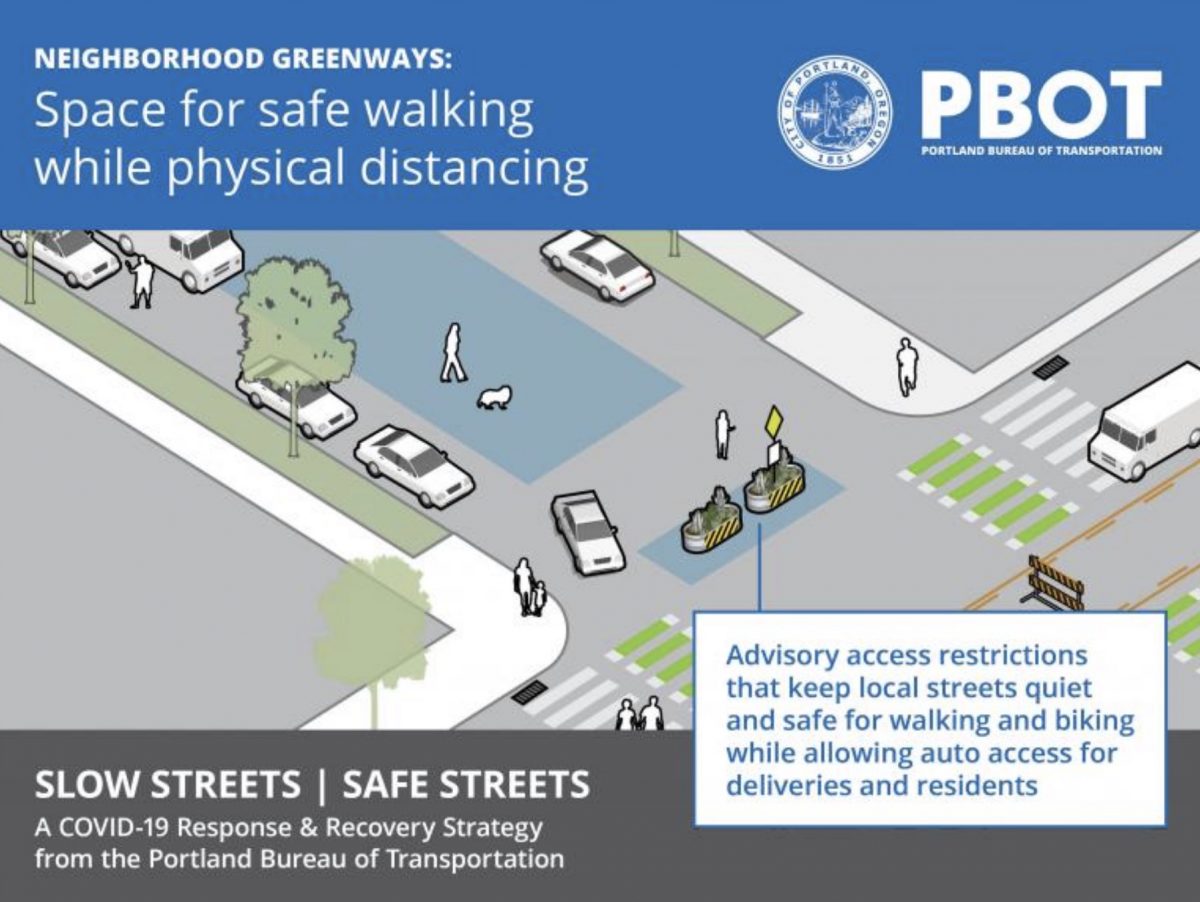
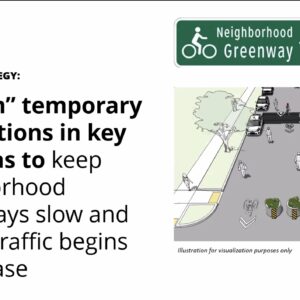
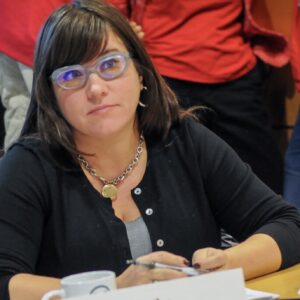
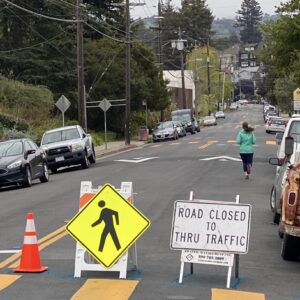
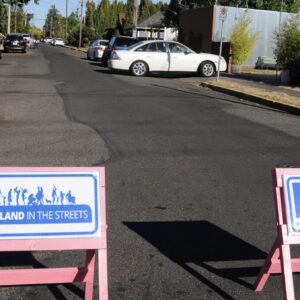
Thanks for reading.
BikePortland has served this community with independent community journalism since 2005. We rely on subscriptions from readers like you to survive. Your financial support is vital in keeping this valuable resource alive and well.
Please subscribe today to strengthen and expand our work.
This looks like a really solid plan. Very grateful that Commissioner Eudaly and PBOT have made this move. Let’s get it rolling out there as soon as possible. If anyone from the Commissioner’s office or PBOT is reading this, there’s a huge community of people who care about our streets who are ready and willing to help!
Hear hear!
How do you get the map? I think I’m on one of the routes, I would like to verify.
there is no map. not yet. They are still trying to decide which streets will get new treatments. stay tuned.
Candidate streets:
https://www.portlandoregon.gov/TRANSPORTATION/article/554110
It’s amazing how great biking in this city could be Portland built real greenways instead of sharrows and speed bumps. That map looks amazing if you ignore the state of the roads that are green
Wow! Very Exciting! Thanks PBOT for taking some initiative and proposing a change. Many thanks Jonathan for continuing to push on this issue. I’m convinced that your determination and persistence helped to keep this issue out front and forced PBOT to come up with something. Well done sir.
Thank you PBOT. It’s embarrassing how long it took for this, but I’ll give kudos where kudos is due.
Yes, finally. Lots of potential here and would be great to expand the neighborhood barricades beyond greenways.
Agreed — there are lots of streets that people use that don’t have a greenway designation.
100 miles! That’s awesome.
Thanks to Jonathan for putting the pressure on City Hall, and kudos to Portland City hall for stepping up and meeting the needs of your city. Now lets hope Vancouver (WA!) is next.
This is great news.
People are already doing this quite a bit seems largely on what are already greenways, I’d love to see some barricades along Bryant and Going. Hopefully this will disperse people from recreating along popular corridors. And curious to see how neighborhoods receive such changes.
I can’t speak for my neighbors but I live on NE 37 and I’ll be pissed if I don’t see barricades. It’s really needed. There are so many walkers, runners and families cycling especially with playgrounds closed. Meanwhile, the streets are largely open for cut through traffic. These drivers aren’t my immediate neighbors, but likely people who got into the habit of taking 37th to avoid 33rd or 42 and continue to use it out of habit even though taking 33rd or 42nd would be faster for them now.
This looks great! I am looking forward to hearing details on how PBOT plans to roll this out. The planters in the greenways image look nice but I hope that won’t be an impediment to rapid deployment. The folding “oiler” barricades they use for special events are a lot faster to set up than planters, but also aren’t as permanent.
Nice work Eudaly, PBOT and to all who made it happen! Certainly a major step forward in creating safer streets in which to move about while not in an automobile. Happy to see Portland step up to follow other cities that have led the charge.
It is great to see design ideas for our region in addition to cars being the dominant form of travel are being seriously considered. There is also the fact that seniors are still the fastest growing part of the population. For many driving is no longer a choice. Often I ask myself could a person with a walker of a wheelchair handle this area? I just hope people remember how to stay safe as traffic gradually increases.
WOW! Yes!!! I’m especially excited about closing greenways to cars. Imagine if they never re-opened. It’s just a dream, but this idea that our streets are a shared outdoor space for use by humans over SUVs, is just thrilling!!!
If this is implemented right, I don’t see why we would ever take out the new diverters. I mean, the entire point of greenways is to prioritize bikers and walkers and local traffic and keep jerk drivers out. This just makes real what we’ve had in our plans and dreams all along. Why would we ever go backwards?
Portland: Hold my beer.
Isn’t this EXACTLY the kind of process concern that Eudaly (rightfully) raised earlier? It is totally NOT legitimate to make a big system-wide change, short-circuiting public process because “it’s only for the duration of the crisis”, then just go ahead and make it permanent.
If PBOT says it’s temporary, it needs to be temporary. If it turns out to have the minimal impact some suggest, it will be easy enough to get public buy-in to make it permanent.
“its not a power grab if its clearly for the common good” is about the slipperiest slope there is.
If everyone (us, the public included) does their job we will use the “temporary” timeframe to do the legwork it takes to make it permanent.
Attempting to short circuit things is exactly what provokes hostile attitudes towards active transport and exacerbates distrust so any good ideas you have won’t even be considered.
The idea that some reconfiguration may be in order while physical distancing measures are in effect is solid, but unashamedly pretending we have issues with sudden crowds when everything is closed and we’re under stay at home orders is realty challenged to put it charitably.
If you really think it’s a great idea to try running roughshod over people without getting buy in, don’t expect people to take you seriously when the same tactics are used by much stronger forces to impose vehicle centric solutions. When you’re in a position of weakness (the frequent use of the term “car culture” in this blog is recognition of who does and who doesn’t have mindshare), trying to do things by force is not a good plan.
Sounds like you’re saying that this will be so wildly popular that even piloting it is akin to short-circuiting the process. If the process prevents even testing things that people believe will be wildly popular, it’s not a very fair process, is it?
Nothing like trampling democracy when you don’t get what you want. It’s nice to see the transportation fascists using the Neocon playbook. Klein’s “Shock Doctrine” pretty well lays bare how the Neocon’s used crises to get around that pesky democracy and force through their unpopular ideas. No crisis, no worries! Just make one up. Look at all the comments talking about how irritating the public process is, and also look at how quickly the conversation pivoted from safety and distancing to making the changes permanent. Because they all know that encouraging everyone to recreate in the same space when at the same time telling them to stay home and stay away from each other clearly doesn’t make sense. But it was never about that. If it was, they would be taking about obvious choke points for essential services. But no, what we’re getting are places for people leisurely recreate when we shouldn’t be doing that. Get your walk, run or ride in, away from people, and get back home. Oh wait, you want to do it where everyone else wants to? Too bad. Go somewhere else. But looking at all the people filling the “closed” parks to picnic and play volleyball (and I did actually see that) clearly indicate that many of us are entirely unwilling to make the simple sacrifices we were asked to make in the name of public safety. It’s shameful.
Also, the idea that the transportation fascists have broad public support is laughable. Do the people who live on greenways want this? Of course they do because it’ll be a win for their property values since they’ll get de facto semi-gated communities. ‘It’s cool disenfranchised poor people, while you can never afford to live here and you can’t use our street to get to that job you live miles and miles away from because we pushed you out years ago, guess what, you can ride your bike here and check out what you don’t have if you want to. So see, we’re totally not actually disenfranchising you more.’ What’s cycling’s road share again? Oh yeah, it’s dirt. And no, if you build it, they will not all come. Basic economics is that if you make a change it effects people at the margins. As in someone who was on the cusp of riding to work but say just didn’t like Intersection X and/or Y, so they drove, will probably start riding if Intersection X or Y was adjusted to their liking. But some one who was in no way inclined to ride, isn’t going to ride because of those changes. Because you know what, they still have to take Billy to soccer practice right after work and that’s on the other side of the river. We don’t all want to live Becky Jo’s Carfree Life. Clearly the vast majority don’t, otherwise they would. Don’t actually have support for the changes you want? No worries, just lie!
I was at the BAC last night and it sounded like there would be plenty of signs indicating how people can give feedback. It also sounded like they were prepared to be flexible based on feedback and even staffing up their 823-Safe line for quicker response times!
I think our normal public outreach process sucks, and I am interested to see how this approach (pilot first, get feedback in real time) works at engaging different people than the usual open houses & online surveys.
I’m a proponent of “pilot first”, but it will only work if the public trusts PBOT. Part of that trust is removing temporary projects when they say they will.
I agree–a lot of these things look like they’d be good to keep. It’s at least a chance to try them in real life. If they don’t make sense long-term exactly where or how they’ve been put in place, they can be taken out, revised or moved or expanded to other locations. I don’t see a problem making any of them permanent if there’s some sort of review prior to deciding that.
hey finally some good news!
Chloe! Chloe! But seriously, I have been very impressed with the way Chloe Eudaly responds to community feedback. She doesn’t always get it the first time, but she listens to the community and often delivers with plans that most politicians wouldn’t touch with a ten foot pole. She’s got my vote.
And thanks to Jonathan (and everyone else) for keeping the pressure on!
Damn. I’d almost move down from Seattle for the next few months — where our city has repurposed 0 inches of downtown street space — or any busy streets — for social distancing.
(don’t worry, I’m not.)
It’s fine to move south to Portland, just not north if you need to travel 300+ miles to get here from your southern departure point.
Glad to finally see this. It will help us over the next year and a half or however long we will need to keep social distancing.
Finally! I doubt it would have happened without ongoing calls for action from people around the city.
Okay… not bad! Better late than never!
What is the city really willing to.do to COERCE decent behavior out of drivers?
I’d like to think actual enforcement would be a start. There is no fear of a negative consequence.
This is going to sound crazy, I know, but imagine if you will that the city had a group of employees who could be empowered to issue fines to people who were driving an a dangerous or illegal manner. I know there would be lots of objections to a system like this, but I actually think it could work.
I would love to see the city roll out a trial of such a system during the crisis, at least on a temporary basis, because there is anecdotal evidence that people are driving like they’re in a post-apocalyptic hellscape filled with hordes of virus addled Sammy Hagar clones singing “I Can’t Drive 55”.
Get out there with the camera, JM, and document how this works out.
Jonathan, is there a source for the “100 miles” headline? I see in the quoted release it mentions 100 miles of greenways, but I don’t see anything in the press release and didn’t hear anything in the advisory committee meeting saying this would be deployed to all greenway locations or to any specific length of streets.
Sounds like they just grabbed 100 out of the air because that’s the total mileage of our greenway network. There’s really no plan yet as far as I can tell. They don’t even have criteria for how to select the greenways and they haven’t shared anything about which locations they’ll do first. Also sounds like it’ll be a few weeks before anything even gets on the ground. More reporting to come. Stay tuned.
And what was your impression of the BAC meeting?
I’ve never attended a BAC meeting before, so I didn’t really know what to expect. I will say that having it online certainly made participation easier! My partner and I were able to cook and eat dinner while listening to the presentations – no way we’d have had time to attend a two hour meeting downtown in person on a normal weeknight. I hope this type of digital participation will be embraced by the city even after the pandemic passes.
It was very informative to see the data presented and to hear what PBOT has been working on. I’m very optimistic about the potential here and think there are some great concepts, but I also have a lot of unresolved questions about how this will be rolled out quickly, efficiently, and equitably. The committee members brought up a lot of the issues I was thinking about. For a plan that PBOT has been working on for “weeks” it did not feel very fully fleshed out, at least to the extent they were willing to share publicly, but I hope we’ll see a lot more details soon. I’m not sure how typical that is of the stage of development plans are typically at when brought to the BAC, but I know with this situation we can’t afford to wait through PBOT’s typical public involvement process where a grand vision gets cut back to weak paint through a months-long process of incremental concessions. I sensed a motivation from PBOT staff to make bolder changes than I’ve seen in the past, and some of the committee members expressed positive surprise at that. I’m hoping the results will be speaking for themselves soon!
When does early voting-by-mail begin for the Portland city council elections?
Permanent Parkways!
Will we at least have specific streets selected before mail-in ballots are due, or is this just a last-minute pander by Eudaly?
I won’t be shocked if we get into June and PBOT announces “community input has lead us to the decision that SE Hawthorne, 39th, Burnside, etc are too busy to reduce vehicle lanes”.
Oh no no, not at all. It will be cancelled for reasons of safety and liability, repercussions of the recent Fallon case on Hawthorne, as well as the huge increase in car traffic.
… Chloe winning the May primary will have nothing to do with that decision, no siree…
Hmmm… I guess there’s still a chance that Chloe will get my vote. I gave her money, but got angrier and angrier, and had decided to vote for Sam. Now I’m vacillating. If she puts in the bus-only lanes that we’re going to desperately need when this is finally over, she’s absolutely got it. She’d better move fast.
A hypothetically progressive PBOT head had to be pushed and pushed into putting minor barriers onto EXISTING greenways in order to slow down traffic after refusing for six weeks, and that has earned your vote?
I’m the opposite. I was on the fence until COVID hit and her lack of inaction showed that in her heart of hearts, she’s a motorist first leader.
I understand your point but a move like this is exactly why incumbents have an unfair advantage in an election…they can use their position to force a policy change the closer it gets to score immediate points with the voter come election time. I’d love to see Portland adopt a model code-of-conduct similar to Indian elections (https://en.wikipedia.org/wiki/Election_Commission_of_India%27s_Model_Code_of_Conduct) to ensure enacting feel-good policies aren’t meant to sway voters at the last minute and eliminate incumbent bias.
I am not complaining about the change (this is great!)—but this came after hesitating for five weeks, and seems more like throwing a bone in exchange for votes. Honestly, more barriers on greenways should have been the norm from the start, and is something I’ve been advocating at BAC meetings for as long as I’ve been attending them.
Hopefully the big game changer is the busy streets (like 39th and Hawthorne, et.al) with their criminally narrow sidewalks.
You mean like this one? (near 39th & Hawthorne)
I meant to 39th, Hawthorne to reflect the general nature of those streets having narrow sidewalks but the image you linked demonstrated my point. 39th/Belmont is bad, and all the area around Laurelhurst park. I keep thinking of Zoolander whenever I seem them: “Is this a sidewalk for ants?” 😉
I’m interested in seeing how giving this space will change the pedestrian atmosphere.
39th sure seems like a good candidate for a center turn lane.
Both 39th and Hawthorne are prime candidates for a 4 to 3 road diet. The lane widths and narrow sidewalks on 39th are really unacceptable, even without a viral crisis.
I walk on these sidewalks daily, and have never questioned the width. I agree that a three lane Hawthorne would be cool, but aren’t there areas that are in more dire need of infrastructure?
The street is getting repaved, so the restiping is essentially “free”. It makes sense to do the reconfiguration now, regardless of how “deserving” other places are.
How absurd to talk about reductions in traffic when people are forced to stay at home and are out of work. When the economy opens back up this will meaningfully create worse traffic conditions which are already terrible. People will always use vehicles regardless of the motive power gas, electric or whatever and penalizing the majority to placate a minor minority of walkers and bikers is highly childish and irresponsible . Looking forward to her removal from office when get to vote soon!
100% of people who drive also walk. It’s not a “minor minority”.
There are a couple of ways we can think about what you’ve said.
First, the idea of penalization: one could reframe it as such—we aren’t taking away; we’ve simply given too much. We’ve given too much license (and too many licenses) to drive at unsafe speeds through places people live and move, given too much consideration to making the automobile the fundamental unit of urban design, given too much veneration to the idea that wide and fast ranging mobility is access, given too much credence to the “drive til you qualify” model of doing things.
Second, that we shouldn’t do things to benefit a minority at the potential inconvenience of a majority (a convenience that is daily purchased at the cost of needlessly lost lives, livelihoods, health, future generations, the environment—consequences which fall most heavily on poor people of color (coming from a Black man whose entire life geography was altered in a moment of traffic violence). We haven’t even broached (and shouldn’t need to) how this brand of convenience is impacting the non-human world). Subjugation of minorities for a supposed “greater good” is a pastime as old as white America itself. Should this simple utilitarian calculation of what most people want or are comfortable with be what guides our decision making? Because that model has sent humanity down dark corridors.
I don’t (only) find fault with your position; your reasoning is disturbing: just because most people do or want a thing doesn’t mean we should continue to provide for or facilitate it.
Bad traffic is not the real problem. The expectation that it should always be good is.
> just because most people do or want a thing doesn’t mean we should continue to provide for or facilitate it
Or, as I heard in a quote whose attribution I can’t determine, “There’s nothing more democratic than a lynch mob.”
Sometimes referred to as “tyranny of the majority”. It’s why we have some built in protections, such as the rule of law and the electoral college.
Yes, cars take up a lot of space, so they easily create traffic jams. Just look at the cities who have spent billions to continually widen their roads (Houston, LA, etc). They still have gridlock. Maybe we need to look at alternatives?
I’ll believe it when I see it.
It’s been 4 weeks since she said she wasn’t doing it. I suspect it’ll be another couple weeks before they decide which streets to do it on. Then the governor will announce that restrictions will be lifted a couple weeks later and PBOT will want to abandon the entire thing citing a lack of need.
When streets are announced I’ll be pleasantly surprised if any popular auto-dominated streets are chosen rather than all on greenways.
Hopefully neighborhood residents will enjoy the temporary diverters so much, they will lobby to make them permanent!
cmh89 April 29, 2020 at 10:36 am
It’s amazing how great biking in this city could be Portland built real greenways instead of sharrows and speed bumps. That map looks amazing if you ignore the state of the roads that are green…
Also a few oddities like the complete break in the, uh, system along the I-84 / NE Sandy axis, as well as the scattered bits of things in SW. Transport, this is NOT.